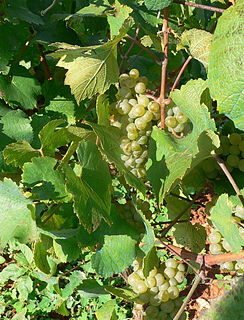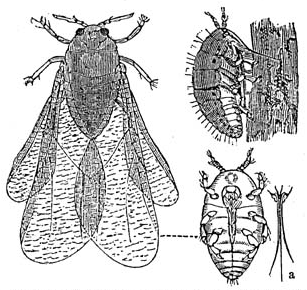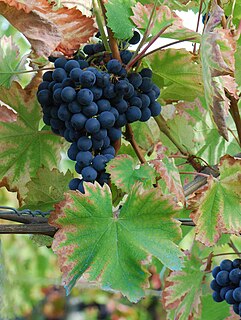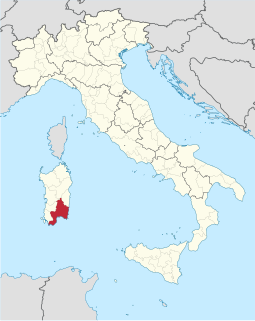
Malvasia is a group of wine grape varieties grown historically in the Mediterranean region, Balearic Islands, Canary Islands and the island of Madeira, but now grown in many of the winemaking regions of the world. In the past, the names Malvasia, Malvazia, and Malmsey have been used interchangeably for Malvasia-based wines; however, in modern oenology, "Malmsey" is now used almost exclusively for a sweet variety of Madeira wine made from the Malvasia grape. Grape varieties in this family include Malvasia bianca, Malvasia di Schierano, Malvasia negra, Malvasia nera, Malvasia nera di Brindisi, Malvasia di Candia aromatica, Malvasia odorosissima, and a number of other varieties.

Grape phylloxera is an insect pest of commercial grapevines worldwide, originally native to eastern North America. Grape phylloxera ; originally described in France as Phylloxera vastatrix; equated to the previously described Daktulosphaera vitifoliae, Phylloxera vitifoliae. The insect is commonly just called phylloxera.

Retsina is a Greek white resinated wine, which has been made for at least 2,000 years. Its unique flavor is said to have originated from the practice of sealing wine vessels, particularly amphorae, with Aleppo Pine resin in ancient times.

The Muscat family of grapes includes over 200 grape varieties belonging to the Vitis vinifera species that have been used in wine production and as raisin and table grapes around the globe for many centuries. Their colors range from white, to yellow, to pink to near black. Muscat grapes and wines almost always have a pronounced sweet floral aroma. The breadth and number of varieties of Muscat suggest that it is perhaps the oldest domesticated grape variety, and there are theories that most families within the Vitis vinifera grape variety are descended from the Muscat variety.

Mourvèdre is a red wine grape variety grown in many regions around the world including the Rhône and Provence regions of France, the Valencia and Jumilla denominaciones de origen of Spain, as well as the Balearic Islands, California and Washington and the Australian regions of South Australia and New South Wales, as well as South Africa. In addition to making red varietal wines, Mourvèdre is a prominent component in "GSM" blends. The variety is also used to make rosé and port-style fortified wines.

In botany, chlorosis is a condition in which leaves produce insufficient chlorophyll. As chlorophyll is responsible for the green color of leaves, chlorotic leaves are pale, yellow, or yellow-white. The affected plant has little or no ability to manufacture carbohydrates through photosynthesis and may die unless the cause of its chlorophyll insufficiency is treated and this may lead to a plant diseases called rusts, although some chlorotic plants, such as the albino Arabidopsis thaliana mutant ppi2, are viable if supplied with exogenous sucrose.

Agiorgitiko is a red Greek wine grape variety that, as of 2012, was the most widely planted red grape variety in Greece, ahead of Xynomavro. The grape has traditionally been grown in the Nemea region of the Peloponnese but can be found throughout the country including Attikí (Attica) and Makedonía (Macedonia).

Assyrtiko or Asyrtiko is a white Greek wine grape indigenous to the island of Santorini. Assyrtiko is widely planted in the arid volcanic-ash-rich soil of Santorini and other Aegean islands, such as Paros. It is also found on other scattered regions of Greece such as Chalkidiki. Assyrtiko is also being grown in Clare Valley, South Australia, and at the Abbey of New Clairvaux in Northern California since 2011. The original Assyrtiko cuttings were imported in the USA in 1948 by Harold Olmo, grape breeder at the University of California, Davis, where they were stored until the abbey of New Clairvaux took interest in the early 2000s.

Greece is one of the oldest wine-producing regions in the world and among the first wine-producing territories in Europe. The earliest evidence of Greek wine has been dated to 6,500 years ago where wine was produced on a household or communal basis. In ancient times, as trade in wine became extensive, it was transported from end to end of the Mediterranean; Greek wine had especially high prestige in Italy under the Roman Empire. In the medieval period, wines exported from Crete, Monemvasia and other Greek ports fetched high prices in northern Europe.

Canaiolo is a red Italian wine grape grown through Central Italy but is most noted in Tuscany. Other regions with plantings of Canaiolo include Lazio, Marche and Sardegna. In Umbria a white berried mutation known as Canaiolo bianco exists. Together with Sangiovese and Colorino it is often used to create Chianti wine and is an important but secondary component of Vino Nobile di Montepulciano. In the history of Chianti it has been a key component blend and during the 18th century may have been the primarily grape used in higher percentage than Sangiovese. Part of its popularity may have been the grape's ability to partially dry out without rotting for use in the governo method of prolonging fermentation. In the 19th century, the Chianti recipe of Bettino Ricasoli called for Canaiolo to play a supporting role to Sangiovese, adding fruitiness and softening tannins without detracting from the wine's aromas. In the aftermath of the phylloxera epidemic, the Canaiolo vines did not take well to grafting onto new American rootstock and the grape began to steadily fall out of favor. As of 2006, total plantings of Canaiolo throughout Italy dropped to under 7,410 acres. Today there are renewed efforts by Tuscan winemakers to find better clonal selections and re-introduce the variety into popular usage.

Muscat Blanc à Petits Grains is a white wine grape of Greek origin that is a member of the Muscat family of Vitis vinifera. Its name comes from its characteristic small berry size and tight clusters. It is known under a variety of local names such as Moscato bianco, Muscat blanc, Muscat Canelli, Muscat de Frontignan, Muscat de Lunel, Muscat d'Alsace, Muskateller, Moscatel de Grano Menudo, Moscatel rosé and Sárgamuskotály.
Bouchalès or Grapput is a red French wine grape variety that is grown primarily in Bordeaux and Southwest France wine appellations. Plantings have declined in recent years as the vine has shown high sensitivity to downy mildew and black rot.
Bonarda Piemontese, now officially listed simply as Bonarda but also known as Bonarda di Chieri and Bonarda del Monferrato is a red Italian wine grape variety that is grown in the northwestern region of Piedmont. Prior to the phylloxera epidemic of the 19th century, Bonarda was speculated to have accounted for 30% of the plantings in Piedmont but today is only found in scattered plantings along the left bank of the Tanaro river near Govone. In the mid-1990s, the grape experienced a slight revival as Piedmontese producers sought to add more aromatics to their Barbera wines by blending in Bonarda.

The Great French Wine Blight was a severe blight of the mid-19th century that destroyed many of the vineyards in France and laid waste the wine industry. It was caused by an aphid that originated in North America and was carried across the Atlantic in the late 1850s. While France is considered to have been worst affected, the blight also did a great deal of damage to vineyards in other European countries.

Lesbos wine is wine made on the Greek island of Lesbos in the Aegean Sea. The island has a long history of winemaking dating back to at least the 7th century BC when it was mentioned in the works of Homer. During this time the area competed with the wines of Chios for the Greek market. An apocryphal account details one of the brothers of the poet Sappho as a merchant trading Lesbos wine with the Greek colony of Naucratis in Egypt. The most noted Lesbos wine was known as Pramnian which draws similarities today to the Hungarian wine Eszencia. The popularity of Lesbos wine continued into Roman times where it was highly valued along with other Aegean wines of Chios, Thasos and Kos.
Ribolla Gialla is a white wine grape grown most prominently in the Friuli region of northeast Italy. The grape is also found in Slovenia where it is known as Rebula. In Friuli, the grape thrives in the region around Rosazzo and Gorizia. In Slovenia, the grape is grown prominently in the Brda region. The grape is not related to the Friuli red wine grape Schioppettino, which is also known as Ribolla Nera. The obscure, lower quality Ribola Verde grape is a mutated version that is not widely used.
Savatiano is a white Greek wine grape used primarily in the wine Retsina. It is one of Greece's most widely planted grape varieties and is known for its resistance to drought condition. It is mostly planted throughout central Greece, particularly in Attica near Athens. In Retsina, the naturally low acidity of the grape is sometimes compensated for by the addition of Assyrtiko and Rhoditis in the blend.

Provence (Provençal) wine comes from the French wine-producing region of Provence in southeast France. The Romans called the area provincia nostra, giving the region its name. Just south of the Alps, it was the first Roman province outside Italy.

Santorini is a Greek wine region located on the archipelago of Santorini in the southern Cyclades islands of Greece. Wine has been produced there since ancient times, but it was during the Middle Ages that the wine of Santorini became famous worldwide under the influence of the Republic of Venice. The Italian influence is still present in modern Santorini winemaking: the most famous Tuscan sweet wine is called Vin Santo just like Santorini's Vinsanto/Visanto. It is made in a passito style from grapes dried in the sun after harvest.

Nasco is a white Italian wine grape variety that is grown primarily in Sardinia around the city of Cagliari. The grape has a long history on the island and is described by wine expert Jancis Robinson as "ancient". There is a special Denominazione di origine controllata (DOC) designation, Nasco di Cagliari, for varietal wines that are 95–100% Nasco.
















